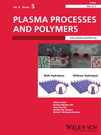Thermal Stability of Superhydrophobic, Nanostructured Surfaces
E. K. Her, T.-J. Ko, B. Shin, H. Roh, W. Dai, W. K. Seong, H.-Y. Kim, K.-R. Lee, K. H. Oh, M.-W. Moon
We report a method to create a self-cleaning, transparent surface on poly(methyl methacrylate) (PMMA) using a dry etching with CF4 plasma and a subsequent hydrolysis process with water immersion. During the CF4 plasma treatment, nanoscale pillar structures were formed and its aspect ratio tended to increase. However, the transparency was reduced due to the deposition and the accumulation of undesired capping layers, which cover the structures. The hydrolysis was used to remove the capping layers of metal fluoride. As a result, the surface improves their clarity based on the transmittance up to 95%, because the reflectivity was reduced. With a subsequent hydrophobic coating, a superhydrophobic surface was achieved showing robust anti-wetting and anti-dewing effects.
